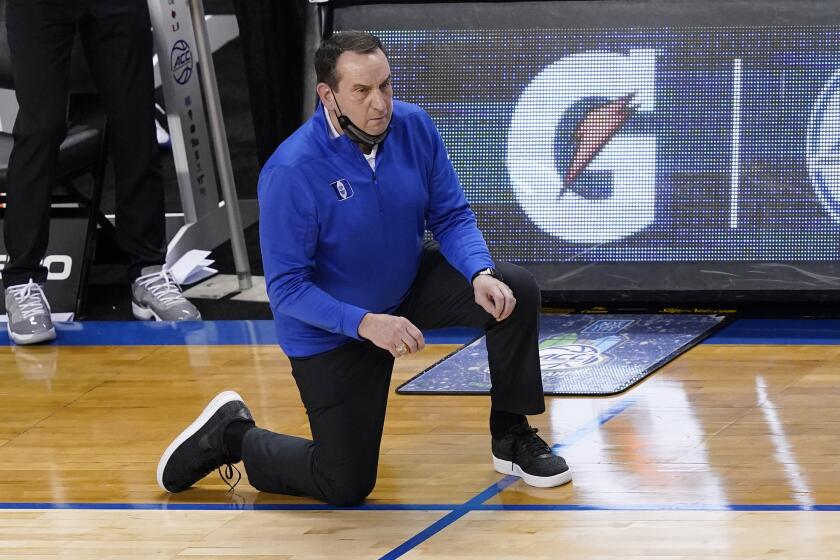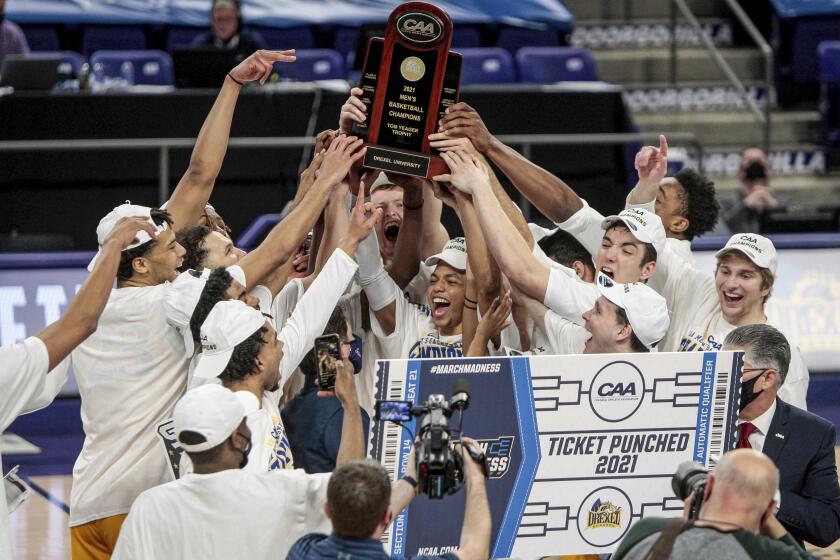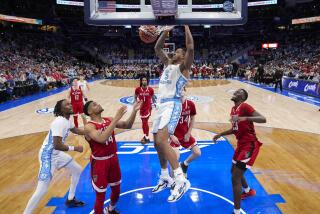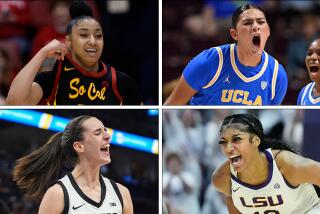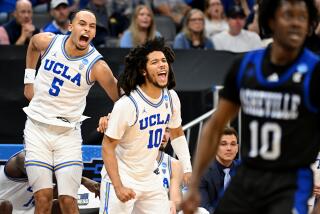Duke’s elimination means pandemic troubles aren’t over yet
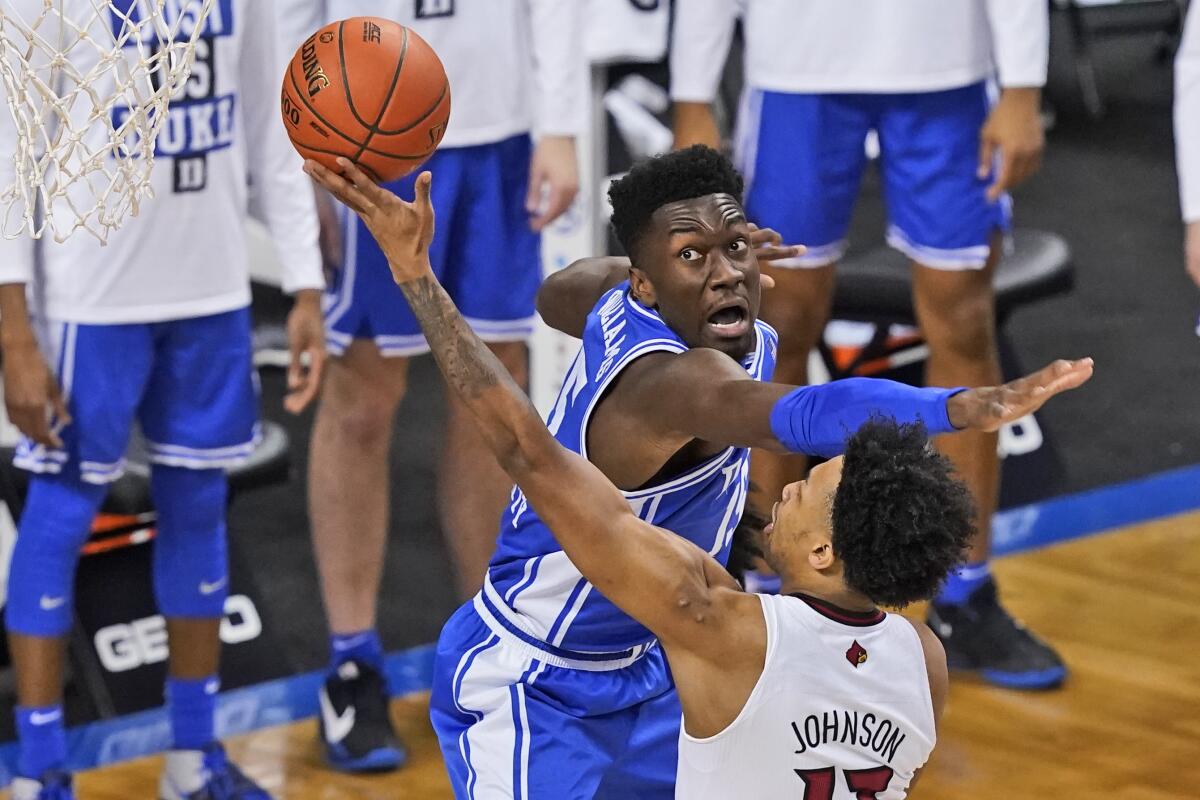
- Share via
A year later, all we want is to feel some sense of normalcy and wrap ourselves up in it. After all we’ve been through, after all we’ve lost, most of us would gladly accept just a small dose.
For me, getting to binge on postseason college basketball in March is about as normal as it gets, and a slate of conference tournament games has never felt as enticing as it did Thursday, 12 months since everything was taken away.
The games themselves hardly mattered and yet the matchups were juiced with intrigue — Syracuse trying to play its way off the bubble against defending national champion Virginia (yes, sadly, that label remains after two years); Oklahoma State and potential No. 1 pick Cade Cunningham taking on Bob Huggins’ raucous West Virginia squad; Patrick Ewing back in Madison Square Garden as the coach of Georgetown, hoping to take down Villanova like old times; and, later in the day, Duke playing Florida State in a must-win for the beleaguered Blue Devils.
But before any ball was tipped Thursday morning, the reality of our fast-improving-yet-never-ending pandemic life butted in again: Duke had a positive COVID-19 test, which meant the Blue Devils were removed from the Atlantic Coast Conference tournament, signaling the end of their season before they could attempt to fully salvage it.
A positive coronavirus test ends Duke’s basketball season, stopping the Blue Devils’ streak of consecutive NCAA tournament appearances at 24.
This being Duke, across the country glee accompanied the news that Mike Krzyzewski’s program will miss the NCAA tournament for the first time since 1995. Those feeding their petty grievances over Coach K’s dominance should take a second to think, though: If it could happen to Duke, which commuted 45 minutes each way between Greensboro, N.C., and Durham on Tuesday and Wednesday in order to keep its pod as tight and as consistent as possible, couldn’t it happen to my team during March Madness?
Anybody could be next. Season over, just like that, just like last season, but even crueler because some other team is going to be covered in confetti in a three-quarters-empty football stadium in Indianapolis on the first Monday in April and fans of the forfeiters would have to live with the “What if?” all offseason.
Seriously, light a candle if your team is one of the 68 chosen on Selection Sunday. Not only do you have to have the requisite pixie dust to get through six games against, say, a zone defense you’ve never seen before, or a three-point marksman who can’t miss, or a crushing injury, you have to have to avoid succumbing to an opponent nobody can see — this ruthless, relentless virus.
The reports out of Durham would be unbelievable if not for hundreds of other instances just like it over the last six months as the college sports industry has chased every TV dollar attached to a media rights contract. Apparently, there has been a COVID outbreak on campus driven by fraternity shenanigans. The football team caught it and has suspended spring practices. Now, a Duke basketball player far down the bench has it, and that’s enough to sit Coach K during the month of Christian Laettner and Shane Battier (although the team’s season-long performance was likely to have done the job without this positive test).
Drexel is headed to the NCAA Tournament for the first time in 25 years after winning the CAA tourney. Cleveland State and Mount St. Mary’s also clinched bids.
Life isn’t stopping on these 68 campuses for the next week either. Just to be allowed into the NCAA tournament’s Indy makeshift bubble, teams have to have tallied a week straight of negative COVID tests. Once there, they’ll be siphoned off on hotel floors and expected to quarantine other than mandatory team activities, which won’t feel that different to most of these players who have sacrificed much personal freedom to put themselves in this position — to entertain us as part of one of sport’s greatest spectacles.
The NCAA has said that as long as a team has five players available for a game that have cleared its COVID protocols that team can play. The NCAA’s protocols are sure to have more leniency baked in, because every game that isn’t staged is money out of schools’ pockets, and the tournament committee would love to avoid a forfeit or having to name a replacement team.
Maybe the association will be lucky, but Thursday reminded us that each time the ball is tipped in Indianapolis we should relish the thrill.
Thursday also gave us a preview of the magic to come. Just in the first hours of the day, Virginia beat Syracuse on a buzzer-beater three, Oklahoma State survived a late West Virginia push and Georgetown squeaked past Villanova, putting the Hoyas two wins from crashing the Big Dance. This sport during this month is just so awesome.
I can’t speak for everyone, but I was absolutely heartbroken when the announcement came last year that the NCAA tournament was canceled. The entire week before, despite the oncoming menace of COVID, I had been trying to convince my wife there was still a way for me to go to Las Vegas for my annual trip with college friends for the first weekend of Madness. Not my proudest moment, in retrospect.
For the next three weeks, I’ll just appreciate every game we get.
Get our high school sports newsletter
Prep Rally is devoted to the SoCal high school sports experience, bringing you scores, stories and a behind-the-scenes look at what makes prep sports so popular.
You may occasionally receive promotional content from the Los Angeles Times.
More to Read
Go beyond the scoreboard
Get the latest on L.A.'s teams in the daily Sports Report newsletter.
You may occasionally receive promotional content from the Los Angeles Times.

